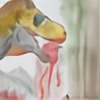HOME | DD
 Dannyp96 — Ceratosaurus sketch
Dannyp96 — Ceratosaurus sketch

Published: 2014-04-22 22:46:42 +0000 UTC; Views: 921; Favourites: 39; Downloads: 1
Redirect to original
Description
Just a quick sketch of C. nasicornis! I only spent about an hour, just kinda playing around with some speculation. This male inflates his large, colorful throat pouch to attract a mate, making deep grumbling sounds, like an Alligator. Didn't wanna spend too much time on a real piece, but I was bored...so here we are






Kinda looked to make a better anatomical rendition of the last Ceratosaurus I did, too.
Related content
Comments: 10

👍: 0 ⏩: 0

Heh thanks. I like that particular coloration too, so I guess I'll have to do another piece with Ceratosaurus again lol
👍: 0 ⏩: 1

You're welcome
Good, hope to see it soon xD
👍: 0 ⏩: 0

That's a quite strong looking Ceratosaurus in the foreground and you've wonderfully captured their expressions. Even a Ceratosaurus needs someone to love
👍: 0 ⏩: 1

Thanks so much for the compliments!
👍: 0 ⏩: 1

You're welcome. Hope, you've a nice day
👍: 0 ⏩: 0

very interesting concept. and I believe this is the first speculative gular pouch ever applied to ceratosaurus.
oh, and quick info. ceratosaurus nasicornis is now often believed to be a junior synonym for ceratosaurus dentisulactus. something sort of like modern birds, where their proportions increase with age and the same result is now belive to be placed with ceratosaurus as well
👍: 0 ⏩: 1

Huh, didn't really think about that. And about the synonymous relationship with C. dentisculatus, that's news to me, and I'll have to read up on it.
👍: 0 ⏩: 1

if your still interested, he some text from carrano el al.(2012)
Two of the new adult specimens have been designated as holotypes of new species, C. dentisulcatus (UMNH VP 5278) and C. magnicornis (MWC 1.1) (Madsen & Welles 2000). However, the purported diagnostic characters of these two species are based almost entirely on proportional differences that are probably attributable to individual and/or ontogenetic variation; many can be specifically attributed to differences in body size. For example, C. magnicornis is supposedly distinguished from C. nasicornis by its ‘more massive’ lac- rimal, dentary and ventral part of the quadratojugal, all of which may simply be the result of allometric scaling. Like- wise, C. dentisulcatus is distinguished by its ‘more massive’ premaxilla, maxilla, dentary, teeth and tibia – all of which might again be due to allometry. Other diagnostic charac- ters relate only to the absolute size of elements, which in larger individuals cannot be interpreted to have systematic meaning. Finally, the genotype specimen of C. nasicornis is an overly fused and pathological individual; some of its features should be interpreted with caution. Accordingly, we
agree with Rauhut (2003) that only one species of Cerato- saurus can be documented in the Morrison Formation.
A femur and tibia from the Late Jurassic of Rodela do Volmita ?o, near Lourinha ?, Portugal have also been referred to Ceratosaurus, along with isolated teeth from other localities (Mateus & Antunes 2000; Antunes & Mateus 2003; Mateus et al. 2006). The tibia apparently more closely resembles that of C. dentisulcatus than C. nasicornis (Mateus & Antunes 2000; Antunes & Mateus 2003; Mateus et al. 2006). How- ever, the supposed similarities are with distorted features of the right tibia of C. dentisulcatus; the left tibia of the same in- dividual is identical to those of other Ceratosaurus ‘species’. Thus we refer to the Portuguese specimen as Ceratosaurus sp. or Ceratosaurus cf. nasicornis.
Read more: theworldofanimals.proboards.co…
👍: 0 ⏩: 0



















